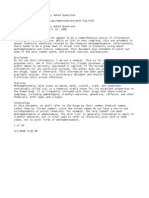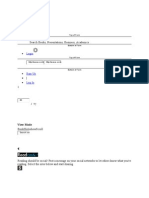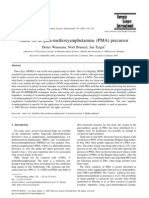Untitled
Untitled
Uploaded by
asimon7117Copyright:
Available Formats
Untitled
Untitled
Uploaded by
asimon7117Original Description:
Copyright
Available Formats
Share this document
Did you find this document useful?
Is this content inappropriate?
Copyright:
Available Formats
Untitled
Untitled
Uploaded by
asimon7117Copyright:
Available Formats
Old school meth: Mexican cartels go back to basics AP FILE - In this July 28, 2009 file photo, a soldier
r organizes a controlled explo sion of a clandestine # By DAVID W. KOOP, Associated Press Writer David W. Koop, Associated Press Writer Mon Dec 14, 2:02 am ET MEXICO CITY Mexican cartels are increasingly going "old school" to keep supplying America with methamphetamine despite an ingredient squeeze. Some gangs have responded to a Mexican crackdown on their meth chemical of choic e pseudoephedrine by reviving a production method so old, it was used by U.S. motorc ycle gangs and bathtub chemists in the 1970s and '80s, recent seizures show. The re-emergence of the "P2P method" demonstrates how frustrating it is to crack down on a synthetic drug that unlike cocaine, heroin and marijuana comes from recipes of chemi cal ingredients, known as "precursors," instead of a plant. When police succeed in cutting off the supply of one precursor, traffickers move on to or make another. "Chemical restrictions are like squeezing mud, the stuff just comes out between your fingers," said Steve Preisler, who wrote the "Secrets of Methamphetamine Manufacture" unde r the nom de plume Uncle Fester and is considered the father of modern meth-making. "They mak e life difficult for the smurfers (home producers) but for people with connections, well, they fi nd it to be no problem at all." Still, authorities contend going after precursors has produced results. The crac kdown contributed to a sharp decrease in meth production in Mexico and a drop in availability on U .S. streets in 2007 and in the first half of 2008, according to the U.S. National Drug Intellig ence Center's 2009 methamphetamine report. And authorities say the P2P method is less desirable for the gangs because it re putedly produces a less-potent drug. But using easy-to-get phenylacetic acid, as well as new sources of contraband ps eudoephedrine, Mexico's meth gangs regrouped, and their output was stabilizing or increasing by late 2008, the drug center's assessment said. The latest turn in the meth fight began in 2005, when Mexican officials started imposing progressively tighter restrictions on imports of the ephedrine and pseudoephedri ne used in cartels' meth labs. A near-total ban on medicines containing pseudoephedrine wen t into effect last year. Traffickers found ways to smuggle the banned chemical into Mexico, and they move d some manufacturing abroad. They also started looking into new ingredients. They came across phenyl-2-propanone, or P2P. While P2P itself is highly restrict ed and closely monitored by authorities, there are many ways to make it. Gangs found they could
get their hands on phenylacetic acid, which can be made into P2P, which in turn can be made into meth. They began acquiring phenylacetic acid and its derivatives in huge quantities. DEA tests of confiscated methamphetamine from Mexico show that in 2007 only 1 pe rcent of meth was made using phenylacetic acid and related chemicals. So far this year, i t is 16 percent. In October, Mexican officials announced the record seizure of 37 tons of phenyla cetic acid derivatives sodium phenylacetate and 2-phenylacetamide that could have made up to 25 tons of crystal meth. The announcement of the coordinated seizures in the border city of Nuevo Laredo and in the Pacific port of Manzanillo also revealed earlier big hauls of phenylacetic acid: 15 tons in May, almost 2 tons in March and 1.8 tons in June and July. "We are starting to see a rise in chemicals that are easier to get," said U.S. D rug Enforcement Administration spokeswoman Dawn Dearden. Preisler, who works at an electroplating factory and has been arrested twice in the U.S. for his work with methamphetamine, says he isn't surprised traffickers have turned to P2 P. "P2P is old school," he said. "Hell, I used to cook by that route circa 1980." The fight has come full circle. In the 1980s, the U.S. government severely restr icted access to P2P seeking to curtail methamphetamine production. Meth makers shifted to ephedr ine, which could be found in common cold remedies. When authorities cracked down on ephedri ne, they switched to pseudoephedrine, the active ingredient in Sudafed and other deconges tants. When U.S. authorities regulated bulk sales of the ephedrines, meth production sh ifted to Mexico, where, at the time, gangs could get their hands on mammoth quantities of pseudoe phedrine imported from China and India. Mexico was soon supplying up to 80 percent of the drug sold in the U.S., and Ame rican authorities were calling meth the No. 2 drug threat to society after cocaine. Once Mexico restricted imports and sales of pseudoephedrine, the cartels took a hit. The volume of methamphetamine seized in the United States fell 34 percent, from 7.1 tons in 2006 to 4.7 tons in 2007, according to the U.S. National Drug Intelligence Cente r. It also said it observed decreased drug purity. Dearden says DEA agents found the price of meth increased. Experts say a crackdown on phenylacetic acid would likely just push traffickers to other chemicals. "People forget that these are synthetically made drugs, and we haven't even seen the end of all "Methamphetamine: Its History, Pharmacology and Treatment."
You might also like
- One Pot (Shake & Bake) Methamphetamine Labs: PresentationDocument0 pagesOne Pot (Shake & Bake) Methamphetamine Labs: PresentationAbdullah S. Abdullah63% (8)
- Opium for the Masses: Harvesting Nature's Best Pain MedicationFrom EverandOpium for the Masses: Harvesting Nature's Best Pain MedicationRating: 5 out of 5 stars5/5 (2)
- Uncle FesterDocument22 pagesUncle Festerjasonleblonde67% (3)
- Industrial Secrets of Ephedrine ProductionDocument36 pagesIndustrial Secrets of Ephedrine ProductionAlessioSonaglio100% (3)
- Methamphetamine SynthesisDocument10 pagesMethamphetamine Synthesisjoejoe6767% (6)
- (Ebook - PDF - Chemistry) Methamphetamine SynthesisDocument4 pages(Ebook - PDF - Chemistry) Methamphetamine SynthesisJOne Nakasamai33% (6)
- Uncle Fester (Author) - Wikipedia, The Free EncyclopediaDocument3 pagesUncle Fester (Author) - Wikipedia, The Free Encyclopediajbellamy9967% (6)
- The Red, White & Blue MethodDocument14 pagesThe Red, White & Blue MethodNeurule Somme-Yong Abdul Jalal80% (5)
- A Simple and Convenient Synthesis of Pseudoephedrine From N-MethylamphetamineDocument2 pagesA Simple and Convenient Synthesis of Pseudoephedrine From N-MethylamphetamineBen Hardy100% (2)
- Drug RecipyDocument73 pagesDrug Recipyomtunion188% (8)
- Benzaldehyde and Mek PatentDocument3 pagesBenzaldehyde and Mek Patentson100% (1)
- The Complete BirchDocument15 pagesThe Complete Birchsparky175lu100% (1)
- ACMD Meth Annex November 2005Document32 pagesACMD Meth Annex November 2005Tara-lea GrillsNo ratings yet
- ClandineDocument90 pagesClandineRicky LeachNo ratings yet
- Method To The Madness - One Jar A Poor Mans Birch Reduction...Document3 pagesMethod To The Madness - One Jar A Poor Mans Birch Reduction...doctorvee75% (4)
- Meth in USA - So So Because It's 50 - 50Document15 pagesMeth in USA - So So Because It's 50 - 50Kyle100% (5)
- Meth ExtractionarticleDocument5 pagesMeth Extractionarticleburhan2875% (4)
- Shake and Bake AAaADocument1 pageShake and Bake AAaAche100% (1)
- Meth FaqDocument6 pagesMeth Faqfelipecam50% (1)
- Large-Scale Methamphetamine Manufacture: Reductive Amination of P2P Through Catalytic Hydrogenation Using Adams CatalystDocument36 pagesLarge-Scale Methamphetamine Manufacture: Reductive Amination of P2P Through Catalytic Hydrogenation Using Adams Catalysthappylm50% (2)
- P2P From Nutra Sweet - Ewok - Poacher - Downlowd Synthetikal - Org Sept (2007) PDFDocument3 pagesP2P From Nutra Sweet - Ewok - Poacher - Downlowd Synthetikal - Org Sept (2007) PDFdextroenantiomerNo ratings yet
- Granddad's Wonderful Book of ChemistryDocument6 pagesGranddad's Wonderful Book of ChemistryKCbob29% (21)
- Benzaldehyde cutePDFDocument105 pagesBenzaldehyde cutePDFlord_enki100% (4)
- The Father of MethDocument4 pagesThe Father of Methjks018767% (6)
- OrganicDocument35 pagesOrganicKristina CoeNo ratings yet
- MaterialsDocument21 pagesMaterialswolftla2100% (1)
- Synthesis Is Relatively SimpleDocument2 pagesSynthesis Is Relatively SimpleWan Bahroni Jiwar Baroes50% (4)
- Birch ReductionDocument5 pagesBirch ReductionShane Pike100% (1)
- Ful BluDocument44 pagesFul BluJamie Lynn Peters TaylorNo ratings yet
- The Clandestine Laboratory Investigating Chemists Association - (WWW - RhodiumDocument18 pagesThe Clandestine Laboratory Investigating Chemists Association - (WWW - Rhodiumdoggy22050% (4)
- Tabletop Uncle FesterDocument669 pagesTabletop Uncle Festerltinez681067% (6)
- Methamphetamine Via Reductive Amination of PhenylDocument3 pagesMethamphetamine Via Reductive Amination of PhenylLaron Clark100% (1)
- Another ReductionDocument41 pagesAnother ReductionHRed100% (2)
- Chem MethDocument3 pagesChem Methr6tjuszuiNo ratings yet
- Stnar34 MetanfetaminasDocument88 pagesStnar34 Metanfetaminashildana pachecoNo ratings yet
- Paul Loo - Convenient Synthesis and Spectroscopic Data of Methcathinone AnalogsDocument27 pagesPaul Loo - Convenient Synthesis and Spectroscopic Data of Methcathinone AnalogsFedrm100% (2)
- T 2144009Document12 pagesT 2144009Duane M. EnckNo ratings yet
- Synthesis of Drug - 2Document44 pagesSynthesis of Drug - 2'Nurirjawati ElRuri KawangNo ratings yet
- The Preparation and Properties of EphedrineDocument6 pagesThe Preparation and Properties of Ephedrinejks0187100% (5)
- Bremer Meth Yield Report PDFDocument9 pagesBremer Meth Yield Report PDFbobc105No ratings yet
- DiEhtylEter RecipeDocument5 pagesDiEhtylEter RecipeVanilla47No ratings yet
- Extracting PsuedoDocument4 pagesExtracting Psuedosevenfoldfallou100% (5)
- Vitnes Synthesis - WikiDocument22 pagesVitnes Synthesis - Wikijohannes karcherNo ratings yet
- GuideDocument8 pagesGuideMichael A. Hackney100% (1)
- Meth Lad Explosive Liquid Recognition PDFDocument2 pagesMeth Lad Explosive Liquid Recognition PDFNick Vendegna100% (2)
- Precursor of Narcotics DrugsDocument6 pagesPrecursor of Narcotics DrugsBibek Singh MahatNo ratings yet
- AniseoilDocument12 pagesAniseoilaml_zgz8233% (3)
- Legal Chemistry: A Guide to the Detection of Poisons, Examination of Tea, Stains, Etc., as Applied to Chemical JurisprudenceFrom EverandLegal Chemistry: A Guide to the Detection of Poisons, Examination of Tea, Stains, Etc., as Applied to Chemical JurisprudenceNo ratings yet
- Young's Demonstrative Translation of Scientific Secrets Or, A Collection of Above 500 Useful Receipts on a Variety of SubjectsFrom EverandYoung's Demonstrative Translation of Scientific Secrets Or, A Collection of Above 500 Useful Receipts on a Variety of SubjectsNo ratings yet
- Microwave Assisted Chemistry Experiments: (Organic Synthesis, Chemical analysis and Extraction)From EverandMicrowave Assisted Chemistry Experiments: (Organic Synthesis, Chemical analysis and Extraction)No ratings yet
- MAKING DMT GUIDE: The essential guide to master the art of making DMT the spirit molecule at home in a simplified wayFrom EverandMAKING DMT GUIDE: The essential guide to master the art of making DMT the spirit molecule at home in a simplified wayNo ratings yet
- Poisons: Their Effects and Detection A Manual for the Use of Analytical Chemists and ExpertsFrom EverandPoisons: Their Effects and Detection A Manual for the Use of Analytical Chemists and ExpertsNo ratings yet



























































